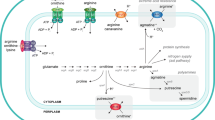Abstract
Rhizobium meliloti adapts to environments of high osmolarity by accumulating glutamate, trehalose, and the dipeptide N-acetylglutaminylglutamine amide (NAGGN) intracellularly. In this study, the mechanism of NAGGN production and accumulation was examined. NAGGN was produced in osmotically shocked cultures after a lag period of more than one hour, and NAGGN was undetectable in cultures treated with chloramphenicol, indicating that genetic induction is required for NAGGN accumulation.In vitro radiolabeling experiments demonstrated that the peptide synthesis step in NAGGN production did not occur ribosomally. Rather, it was catalyzed by an ATP-dependent enzyme that appeared to be both induced by high osmolarity and activated by K+. Also, a mutant analysis suggested that NAGGN may be partly responsible for the osmotic tolerance observed inR. meliloti. 36% of mutants that were characterized as osmotically sensitive compared to the parent strain, were also found to contain reduced levels of NAGGN. The phenomenon of osmolyte accumulation as it relates to adaptation to other environmental stresses is discussed.
Similar content being viewed by others
Abbreviations
- MCAA:
-
malate-casamino acids medium
- NAGG:
-
N-acetylglutaminylglutamine
- NAGGN:
-
N-acetylglutaminylglutamine amide
References
Botsford J L 1984 Osmoregulation inRhizobium meliloti: inhibition of growth by salts. Arch. Microbiol. 137, 124–127.
Botsford J L and Lewis T A 1990 Osmoregulation inRhizobium meliloti: production of glutamic acid in response to osmotic stress. Appl. Environ. Microbiol. 56, 488–494.
Crowe J H, Hoekstra F A and Crowe L M 1992 Anhydrobiosis. Annu. Rev. Physiol. 54, 579–599.
Csonka L N and Hanson A D 1991 Prokaryotic osmoregulation: genetics and physiology. Annu. Rev. Microbiol. 45, 569–606.
Elsheikh E A E and Wood M 1990 Rhizobia and bradyrhizobia under salt stress: possible role of trehalose in osmoregulation. Lett. Appl. Microbiol. 10, 127–129.
Eshoo M W 1988lac Fusion analysis of thebet genes ofEscherichia coli: regulation by osmolarity, temperature, oxygen, choline and glycine betaine. J. Bacteriol. 170, 5208–5215.
Hengge-Aronis R, Klein W, Lange R, Rimmele M and Boos W 1991 Trehalose synthesis genes are controlled by the putative sigma factor encoded byrpoS and are involved in stationary-phase thermotolerance inEscherichia coli. J. Bacteriol. 173, 7918–7924.
Hua S-S T, Tsai V Y, Lichens G M and Noma A T 1982 Accumulation of amino acids inRhizobium sp. strain WR1001 in response to sodium chloride salinity. Appl. Environ. Microbiol. 44, 135–140.
Mary P, Ochin D and Tailliez R 1986 Growth status of Rhizobia in relation to their tolerance to low water activities and desiccation stresses. Soil Biol. Biochem. 18, 179–184.
Miller J H 1972 Experiments in Molecular Genetics. Cold Spring Harbor Laboratory.
Powers-Lee S G 1985 N-Acetylglutamate synthase. Meth. Enzymol. 113, 27–35.
Shortridge V D, Lazdunski A and Vasil M L 1992 Osmoprotectants and phosphate regulate expression of phospholipase C inPseudomonas aeruginosa. Molec. Microbiol. 6, 863–871.
Severin J, Wohlfarth A and Galinski E A 1992 The predominant role of recently discovered tetrahydropyrimidines for the osmoadaptation of halophilic eubacteria. J. Gen. Microbiol. 138, 1629–1638.
Smith L T and Smith G M 1989 An osmoregulated dipeptide in stressedRhizobium meliloti. J. Bacteriol. 171, 4714–4717.
Smith L T, Smith G M, D'Souza M R, Pocard J-A, Le Rudulier D and Madkour M A 1994 Osmoregulation inRhizobium meliloti: mechanism and control by other environmental signals. J. Exper. Zool. 268, 162–165.
Storey K B and Storey J M 1983 Biochemistry of freeze toleranace in terrestrial insects. TIBS 8, 242–245.
Yancey P H, Clark M E, Hand S C, Bowlus R D and Somero G N 1982 Living with water stress: evolution of osmolyte systems. Science 217, 1214–1222.
Yap S F and Lim S T 1983 Response ofRhizobium sp. UMKL 20 to sodium chloride stress. Arch. Microbiol. 135, 224–228.
Yelton M M, Yang S S, Edie S A and Lim S T 1983 Characterization of an effective salt-tolerant, fast-growing strain ofRhizobium japonicum. J. Gen. Microbiol. 129, 1537–1547.
Author information
Authors and Affiliations
Rights and permissions
About this article
Cite this article
Smith, L.T., Allaith, A.A. & Smith, G.M. Mechanism of osmotically regulated N-acetylglutaminylglutamine amide production inRhizobium meliloti . Plant Soil 161, 103–108 (1994). https://doi.org/10.1007/BF02183090
Issue Date:
DOI: https://doi.org/10.1007/BF02183090




